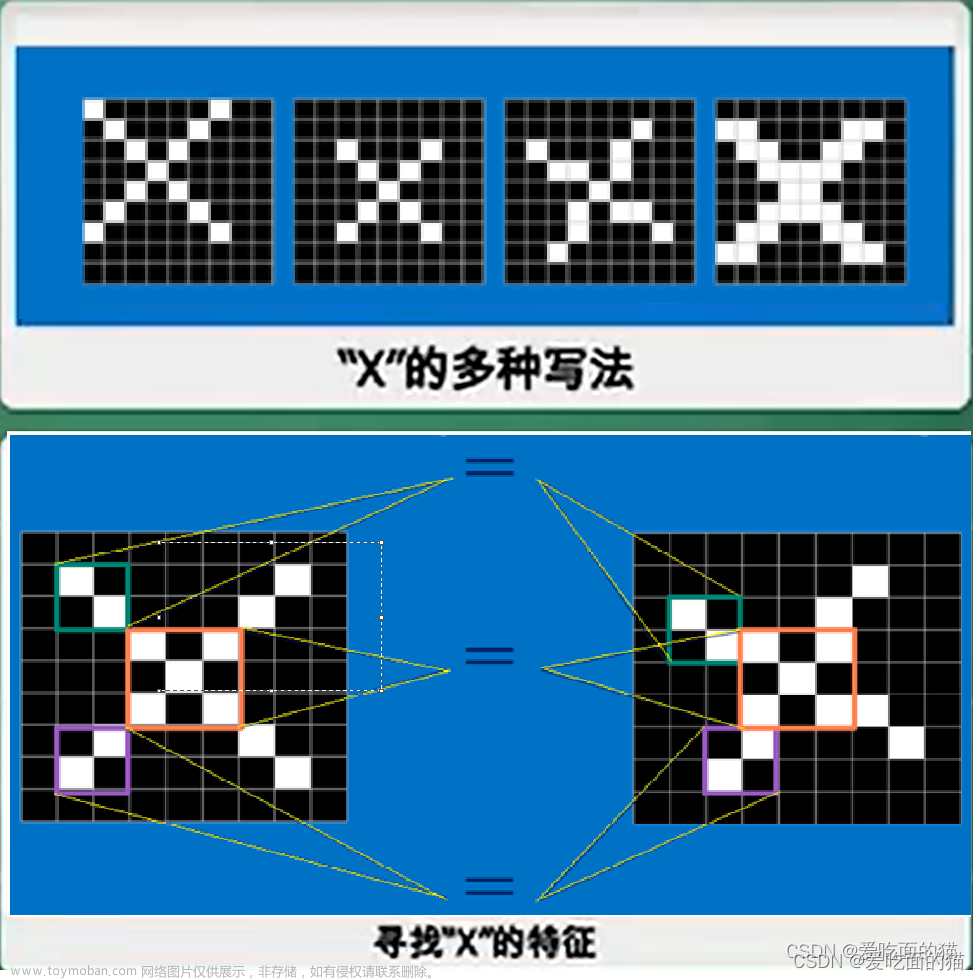1.ACMIX 卷积与注意力融合
论文地址:https://arxiv.org/pdf/2111.14556.pdf
为了实现卷积与注意力的融合,我们让特征图经过两个路径,一个路径经过卷积,另外一个路径经过Transformer,但是,现在有一个问题,卷积路径比较快,Transformer比较慢。因此,我们让Q,K,V通过1*1的卷积得到,同时使用窗口注意力,同时将3*3的卷积分解为1*1的卷积,从而共享参数。

如下图所示,对于卷积,stage1用1*1的卷积代替3*3的卷积,得到不同位置的特征,stage2再利用类卷积操作进行偏移,实现3*3卷积的效果;对于自注意力机制,首先使用1^1的卷积得到q,k,v,然后再进行自注意力计算。然后进行组合,共享1*1的卷积,然后分别走卷积和自注意力。

代码详解:
难点:窗口注意力的实现
我们在上文提到,自注意了机制是按照窗口进行计算的,具体实现是,首先我们对key做一个特征整合,具体来说是按照一个窗口重构出特征,然后对q中的每一个特征点,与key的窗口进行自注意力计算。

class ACmix(nn.Module):
def __init__(self, in_planes, out_planes, kernel_att=7, head=4, kernel_conv=3, stride=1, dilation=1):
super(ACmix, self).__init__()
self.in_planes = in_planes
self.out_planes = out_planes
self.head = head
self.kernel_att = kernel_att
self.kernel_conv = kernel_conv
self.stride = stride
self.dilation = dilation
self.rate1 = torch.nn.Parameter(torch.Tensor(1))
self.rate2 = torch.nn.Parameter(torch.Tensor(1))
self.head_dim = self.out_planes // self.head
self.conv1 = nn.Conv2d(in_planes, out_planes, kernel_size=1)
self.conv2 = nn.Conv2d(in_planes, out_planes, kernel_size=1)
self.conv3 = nn.Conv2d(in_planes, out_planes, kernel_size=1)
self.conv_p = nn.Conv2d(2, self.head_dim, kernel_size=1)
self.padding_att = (self.dilation * (self.kernel_att - 1) + 1) // 2
self.pad_att = torch.nn.ReflectionPad2d(self.padding_att)
self.unfold = nn.Unfold(kernel_size=self.kernel_att, padding=0, stride=self.stride)
self.softmax = torch.nn.Softmax(dim=1)
self.fc = nn.Conv2d(3 * self.head, self.kernel_conv * self.kernel_conv, kernel_size=1, bias=False)
self.dep_conv = nn.Conv2d(self.kernel_conv * self.kernel_conv * self.head_dim, out_planes,
kernel_size=self.kernel_conv, bias=True, groups=self.head_dim, padding=1,
stride=stride)
self.reset_parameters()
def reset_parameters(self):
init_rate_half(self.rate1)
init_rate_half(self.rate2)
kernel = torch.zeros(self.kernel_conv * self.kernel_conv, self.kernel_conv, self.kernel_conv)
for i in range(self.kernel_conv * self.kernel_conv):
kernel[i, i // self.kernel_conv, i % self.kernel_conv] = 1.
kernel = kernel.squeeze(0).repeat(self.out_planes, 1, 1, 1)
self.dep_conv.weight = nn.Parameter(data=kernel, requires_grad=True)
self.dep_conv.bias = init_rate_0(self.dep_conv.bias)
def forward(self, x):
# 经过1*1的卷积得到q,k,v,同时也是后面进行共享的特征图
q, k, v = self.conv1(x), self.conv2(x), self.conv3(x)
# 归一化q*k/根号k
scaling = float(self.head_dim) ** -0.5
b, c, h, w = q.shape
h_out, w_out = h // self.stride, w // self.stride
# ### att
# ## positional encoding 位置编码
pe = self.conv_p(position(h, w, x.is_cuda))
q_att = q.view(b * self.head, self.head_dim, h, w) * scaling
k_att = k.view(b * self.head, self.head_dim, h, w)
v_att = v.view(b * self.head, self.head_dim, h, w)
if self.stride > 1:
q_att = stride(q_att, self.stride)
q_pe = stride(pe, self.stride)
else:
q_pe = pe
# 重构key,得到窗口特征
unfold_k = self.unfold(self.pad_att(k_att)).view(b * self.head, self.head_dim,
self.kernel_att * self.kernel_att, h_out,
w_out) # b*head, head_dim, k_att^2, h_out, w_out
unfold_rpe = self.unfold(self.pad_att(pe)).view(1, self.head_dim, self.kernel_att * self.kernel_att, h_out,
w_out) # 1, head_dim, k_att^2, h_out, w_out
att = (q_att.unsqueeze(2) * (unfold_k + q_pe.unsqueeze(2) - unfold_rpe)).sum(
1) # (b*head, head_dim, 1, h_out, w_out) * (b*head, head_dim, k_att^2, h_out, w_out) -> (b*head, k_att^2, h_out, w_out)
att = self.softmax(att)
out_att = self.unfold(self.pad_att(v_att)).view(b * self.head, self.head_dim, self.kernel_att * self.kernel_att,
h_out, w_out)
out_att = (att.unsqueeze(1) * out_att).sum(2).view(b, self.out_planes, h_out, w_out)
## conv 共享q,k,v,进行卷积特征提取
f_all = self.fc(torch.cat(
[q.view(b, self.head, self.head_dim, h * w), k.view(b, self.head, self.head_dim, h * w),
v.view(b, self.head, self.head_dim, h * w)], 1))
f_conv = f_all.permute(0, 2, 1, 3).reshape(x.shape[0], -1, x.shape[-2], x.shape[-1])
out_conv = self.dep_conv(f_conv)
# 特征融合
return self.rate1 * out_att + self.rate2 * out_conv2.2.GCnet(全局特征融合)
https://arxiv.org/abs/1904.11492
以前我们使用注意力机制计算在整幅图像进行自注意力计算,但是开销巨大。同时。作者发现,图像中的重要的特征点往往集中在特定区域内,比如集中在前景区域。因此,作者提出将这些重要的特征进行获取并凸显出来。

整体做法比较简单,就是使用1*1的卷积和softmax获取全局重要的特征,然后通过残差模块加入到原始特征中。

代码:
class CB2d(nn.Module):
def __init__(self, inplanes, pool='att', fusions=['channel_add', 'channel_mul']):
super(CB2d, self).__init__()
assert pool in ['avg', 'att']
assert all([f in ['channel_add', 'channel_mul'] for f in fusions])
assert len(fusions) > 0, 'at least one fusion should be used'
self.inplanes = inplanes
self.planes = inplanes // 4
self.pool = pool
self.fusions = fusions
if 'att' in pool:
self.conv_mask = nn.Conv2d(inplanes, 1, kernel_size=1)
self.softmax = nn.Softmax(dim=2)
else:
self.avg_pool = nn.AdaptiveAvgPool2d(1)
if 'channel_add' in fusions:
self.channel_add_conv = nn.Sequential(
nn.Conv2d(self.inplanes, self.planes, kernel_size=1),
nn.LayerNorm([self.planes, 1, 1]),
nn.ReLU(inplace=True),
nn.Conv2d(self.planes, self.inplanes, kernel_size=1)
)
else:
self.channel_add_conv = None
if 'channel_mul' in fusions:
self.channel_mul_conv = nn.Sequential(
nn.Conv2d(self.inplanes, self.planes, kernel_size=1),
nn.LayerNorm([self.planes, 1, 1]),
nn.ReLU(inplace=True),
nn.Conv2d(self.planes, self.inplanes, kernel_size=1)
)
else:
self.channel_mul_conv = None
self.reset_parameters()
def reset_parameters(self):
if self.pool == 'att':
kaiming_init(self.conv_mask, mode='fan_in')
self.conv_mask.inited = True
if self.channel_add_conv is not None:
last_zero_init(self.channel_add_conv)
if self.channel_mul_conv is not None:
last_zero_init(self.channel_mul_conv)
def spatial_pool(self, x):
batch, channel, height, width = x.size()
# 得到图像中各个特征点的权重
if self.pool == 'att': # iscyy
input_x = x
input_x = input_x.view(batch, channel, height * width)
input_x = input_x.unsqueeze(1)
# mask即特征点的权重,首先使用卷积,然后使用softmax操作
context_mask = self.conv_mask(x)
context_mask = context_mask.view(batch, 1, height * width)
context_mask = self.softmax(context_mask)
context_mask = context_mask.unsqueeze(3)
# 将权重作用到原始特征图
context = torch.matmul(input_x, context_mask)
context = context.view(batch, channel, 1, 1)
else:
context = self.avg_pool(x)
return context
def forward(self, x):
context = self.spatial_pool(x)
# 在通道层面学习一个权重和偏置项
if self.channel_mul_conv is not None:
channel_mul_term = torch.sigmoid(self.channel_mul_conv(context))
out = x * channel_mul_term
else:
out = x
if self.channel_add_conv is not None:
channel_add_term = self.channel_add_conv(context)
out = out + channel_add_term
return out3.Coordinate_attention
论文地址:https://arxiv.org/abs/2103.02907
这篇论文实现的是一种坐标轴注意力。SENet通过全局池化去学习通道注意力,CBAM不仅学习通道注意力,而且学习特征图的空间注意力。这篇论文更近一步,分坐标轴去学习注意力权重。

具体来说,首先分别沿着H,W维度分别进行平均池化,得到X轴和Y轴的特征,以此为基础或者X轴注意力和Y轴注意力。很显然,H维度和W维度并不是独立的,我们还得考虑它们的关系,因此,我们将他们拼接,并通过卷积进行特征的融合,然后再进行切分,经过sigmoid得到X轴和Y轴的注意力权重。那么,我们如何得到整个特征图的权重呢?直接将两个轴的权重进行矩阵乘法不就得到了整个特征图的权重吗?

代码链接:
class CA(nn.Module):
# Coordinate Attention for Efficient Mobile Network Design
'''
Recent studies on mobile network design have demonstrated the remarkable effectiveness of channel attention (e.g., the Squeeze-and-Excitation attention) for lifting
model performance, but they generally neglect the positional information, which is important for generating spatially selective attention maps. In this paper, we propose a
novel attention mechanism for mobile iscyy networks by embedding positional information into channel attention, which
we call “coordinate attention”. Unlike channel attention
that transforms a feature tensor to a single feature vector iscyy via 2D global pooling, the coordinate attention factorizes channel attention into two 1D feature encoding
processes that aggregate features along the two spatial directions, respectively
'''
def __init__(self, inp, oup, reduction=32):
super(CA, self).__init__()
mip = max(8, inp // reduction)
self.conv1 = nn.Conv2d(inp, mip, kernel_size=1, stride=1, padding=0)
self.bn1 = nn.BatchNorm2d(mip)
self.act = h_swish()
self.conv_h = nn.Conv2d(mip, oup, kernel_size=1, stride=1, padding=0)
self.conv_w = nn.Conv2d(mip, oup, kernel_size=1, stride=1, padding=0)
def forward(self, x):
identity = x
# 沿着H,W维度分别进行平均池化
n, c, h, w = x.size()
pool_h = nn.AdaptiveAvgPool2d((h, 1))
pool_w = nn.AdaptiveAvgPool2d((1, w))
x_h = pool_h(x)
x_w = pool_w(x).permute(0, 1, 3, 2)
# H,W维度拼接,经过卷积进行特征提取,进一步学习H,W维度的关联
y = torch.cat([x_h, x_w], dim=2)
y = self.conv1(y)
y = self.bn1(y)
y = self.act(y)
# 分离H,W维度
x_h, x_w = torch.split(y, [h, w], dim=2)
x_w = x_w.permute(0, 1, 3, 2)
# 经过sigmoid得到注意力权重
a_h = self.conv_h(x_h).sigmoid()
a_w = self.conv_w(x_w).sigmoid()
# 将坐标轴的注意力作用到原特征图
out = identity * a_w * a_h
return out4.SPD(可替换下采样)
论文地址:https://arxiv.org/abs/2208.03641
传统的下采样使用stride的卷积或者池化,这可能会导致信息的丢失,这篇论文提出了一种新的下采样方式,首先,对原始特征图进行间隔采样,得到分组。这时候通道数变为了原来的4倍,然后再使用1*1的卷积进行降维。

class space_to_depth(nn.Module):
# Changing the dimension of the Tensor
def __init__(self, dimension=1):
super().__init__()
self.d = dimension
def forward(self, x):
return torch.cat([x[..., ::2, ::2], x[..., 1::2, ::2], x[..., ::2, 1::2], x[..., 1::2, 1::2]], 1)5.可变形卷积加入方法
最近,pytorch加入了可变形卷积,参数如下,需要我们指定输入(特征图)和偏移量,当使用3*3的卷积时,偏移量为3*3*2=18。

导入:from torchvision.ops import Deformconv2d
offset:用卷积定义offset
self.offset=nn.Conv2d(512,18, 3, padding=1, bias=True)
self.torchvision_dcn2d = Deformconv2(512, 512, 3, stride=1, padding=1)
forward:
offset = self.torchvision_offset(x)文章来源:https://www.toymoban.com/news/detail-695972.html
x= self.torchvision_dcn2d(x,offset)
文章来源地址https://www.toymoban.com/news/detail-695972.html
到了这里,关于人工智能论文通用创新点(一)——ACMIX 卷积与注意力融合、GCnet(全局特征融合)、Coordinate_attention、SPD(可替换下采样)的文章就介绍完了。如果您还想了解更多内容,请在右上角搜索TOY模板网以前的文章或继续浏览下面的相关文章,希望大家以后多多支持TOY模板网!










